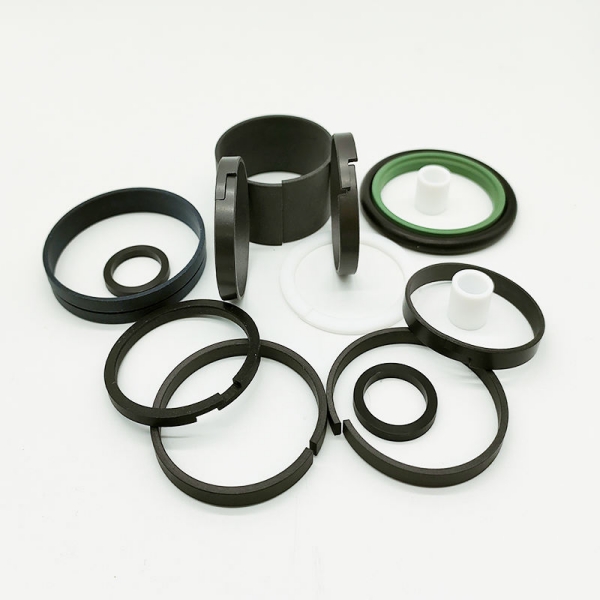2. Selection of common sealing materials Different materials have their own advantages and disadvantages in terms of chemical resistance, temperature resistance and mechanical properties.
The following are several common sealing materials and their applications in strong acid and alkali environments:
2.1 Fluoroelastomer (FKM/Viton) Fluoroelastomer (FKM) is a rubber material with superior chemical resistance, capable of withstanding the corrosion of many strong acids. Its strength lies in its resistance to high temperatures, as well as its excellent performance in oils, fuels and many organic solvents. However, Viton is less resistant to strong bases (e.g., sodium hydroxide, potassium hydroxide), so it is not recommended for use in strong alkaline environments.
Advantages: Good resistance to strong acids and high temperature resistance.
Disadvantages: poor resistance to strong alkali, high cost.
Applicable environment: strong acid environment, especially in high temperature demand.
2.2 Perfluoroelastomer (FFKM/Perfluoroelastomer) Perfluoroelastomer (FFKM) is one of the elastomer materials with the most superior chemical resistance. It is resistant to almost all types of acids, alkalis, solvents and other chemicals, and remains stable at high temperatures. This material maintains its sealing properties for a long time, even under extreme conditions, and is the “top of the line” among sealing materials in the chemical industry.
Advantages: excellent chemical resistance, high temperature resistance, suitable for the most demanding working conditions.
Disadvantages: extremely high cost, not suitable for large-scale application in cost-sensitive equipment.
Applicable environment: strong acid, alkali, high temperature and highly corrosive environment.
2.3
Polytetrafluoroethylene (
PTFE/
teflon) Polytetrafluoroethylene (PTFE) has very high chemical stability and corrosion resistance, and hardly reacts with any acid, alkali or solvent. In addition to this, PTFE is able to withstand extremely high temperatures and is therefore widely used in strong acid and alkali environments. Its only drawback is its poor elasticity, which needs to be combined with other elastomers to achieve better sealing results.
Advantages: chemically resistant, high temperature resistant, suitable for almost all corrosive environments.
Disadvantages: poor elasticity, may need to be used in conjunction with other materials.
Applicable environment: strong acid, strong alkali, solvents and high temperature environment.
2.4 Ethylene Propylene Rubber (EPDM) Ethylene Propylene Rubber (EPDM) performs well in strong alkaline environments, and is especially suitable for applications in contact with alkaline solutions. Also, EPDM has good resistance to acidic solutions at certain concentrations. However, it is less resistant to mineral oils and organic solvents, so it is not recommended for applications involving oils.
Advantages: Excellent performance in alkaline environments, moderately priced.
Disadvantages: Not resistant to oils and organic solvents.
Applicable environment: strong alkaline environment, suitable for low and medium concentration acidic environment.
2.5 Chloroprene Rubber (CR/Neoprene) Chloroprene rubber has a certain degree of chemical resistance, and performs well in medium-strength acid and alkali solutions. It excels in oxidation and ozone resistance and is relatively inexpensive, making it suitable for use in applications where the requirements for corrosion resistance are not extremely high.
Advantages: ozone resistance, oxidation resistance, low cost.
Disadvantages: Not suitable for strong acid and alkali environments.
Suitable environment: mildly corrosive environment, strong oxidizing gas environment

3. Practical application strategies for material selection In practical applications, the following factors should be considered when selecting a seal material:
Chemical resistance: Determine the main types of chemicals (acids, alkalis or solvents) and their concentrations in the environment to ensure the chemical resistance of the selected material.
Temperature range: Ambient temperature is a key factor, especially in high-temperature situations where the thermal stability of the material is important.
Mechanical stresses: The mechanical stresses (e.g. compression, shear, etc.) that may be generated during the operation of the equipment require the selection of a material with sufficient elasticity and strength.
Cost factors: If cost-sensitive, you can use high-end materials such as FFKM in localized areas, while choosing less expensive materials such as EPDM in more relaxed areas.
4. Summarize in the strong acid, alkali environment, the choice of sealing material is directly related to the sealing effect and service life of the equipment. Fluorine rubber, perfluoroether rubber, polytetrafluoroethylene and ethylene propylene rubber and other materials have their own advantages and disadvantages, the choice of the environment needs to take into account the chemical properties, temperature, mechanical stress and cost factors. For highly corrosive environments, PFE and PTFE are ideal, while in cost-sensitive or less corrosive applications, EPDM and neoprene are suitable alternatives.






